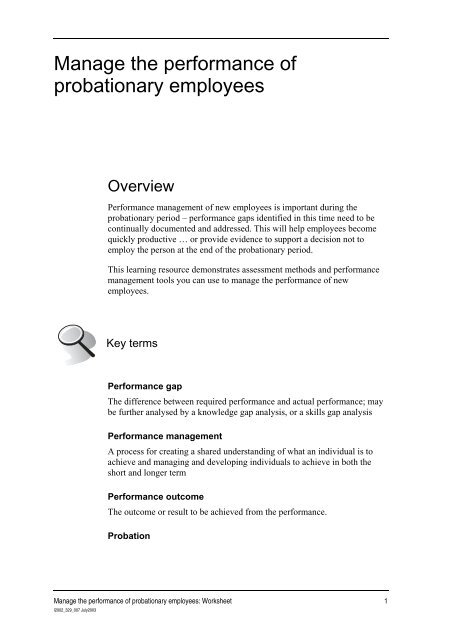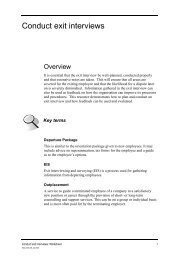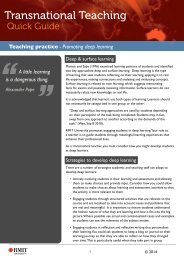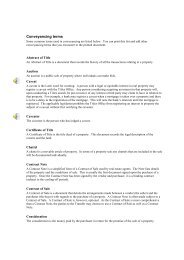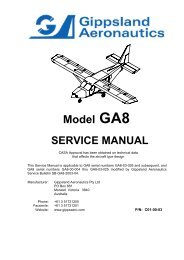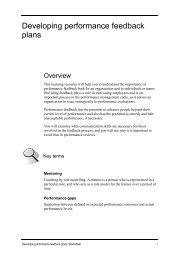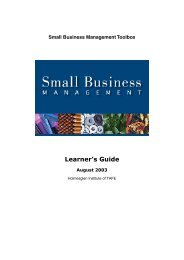Probation worksheet - PDF - Flexible Learning Toolboxes
Probation worksheet - PDF - Flexible Learning Toolboxes
Probation worksheet - PDF - Flexible Learning Toolboxes
You also want an ePaper? Increase the reach of your titles
YUMPU automatically turns print PDFs into web optimized ePapers that Google loves.
Manage the performance of<br />
probationary employees<br />
Overview<br />
Performance management of new employees is important during the<br />
probationary period – performance gaps identified in this time need to be<br />
continually documented and addressed. This will help employees become<br />
quickly productive … or provide evidence to support a decision not to<br />
employ the person at the end of the probationary period.<br />
This learning resource demonstrates assessment methods and performance<br />
management tools you can use to manage the performance of new<br />
employees.<br />
Key terms<br />
Performance gap<br />
The difference between required performance and actual performance; may<br />
be further analysed by a knowledge gap analysis, or a skills gap analysis<br />
Performance management<br />
A process for creating a shared understanding of what an individual is to<br />
achieve and managing and developing individuals to achieve in both the<br />
short and longer term<br />
Performance outcome<br />
The outcome or result to be achieved from the performance.<br />
<strong>Probation</strong><br />
Manage the performance of probationary employees: Worksheet 1<br />
I2002_329_007 July2003
A specified period, at the end of which an employment contract may be<br />
continued or terminated; is best used in conjunction with a performance<br />
management and appraisal system<br />
Performance management of new<br />
employees<br />
Performance management techniques for new employees could include:<br />
• Regular meetings with their line manager to summarise feedback on<br />
work performance, and clarify the performance standards and<br />
performance criteria of the job<br />
• Periodic review of the induction checklist to ensure all items are<br />
covered and to identify gaps<br />
• Collaborative goal setting (with the line manager) against the<br />
performance criteria for the job<br />
• Knowledge gap analysis and skills gap analysis where the employee<br />
is performing below standard<br />
• Collaborative development (with the line manager) of a learning<br />
plan<br />
• Formal reviews using tools such as performance appraisal forms –<br />
this may be linked with a wider performance appraisal system for<br />
the organisation<br />
Performance management systems can help probationary employees<br />
develop a clear understanding of what is required of them. They can also<br />
provide opportunities for the new employee to ask questions and be<br />
involved in their own training plans and in workgroup decision making.<br />
Think<br />
Remember your first 3 months on a job you have done. What aspects of<br />
your work did you find frustrating What things made you unhappy or<br />
annoyed<br />
Could any of these things been prevented by a more organised approach to<br />
performance management<br />
2 Manage the performance of probationary employees: Worksheet<br />
I2002_329_007 July2003
Identifying the learning needs of new<br />
employees<br />
The learning needs for new employees, whether identified during selection,<br />
during induction, or soon after being introduced to the job can be identified<br />
though a performance gap analysis. With the requirements of the job<br />
already analysed and described in the job description you will be well<br />
placed to do a gap analysis.<br />
You can then an appraisal form that enables the team leader or supervisor to<br />
make a judgement on the ability of the new worker to undertake the<br />
elements of the job identified in the job analysis.<br />
Example<br />
Consider the following scenario at a large seed propagation nursery.<br />
Vijendra has been appointed the Supervisor of the nursery. Despite having<br />
tertiary qualification in environmental studies and first-line management,<br />
and ten years work experience in nursery work in Victoria, Vijendra has<br />
never worked in Queensland.<br />
The interviewing panel appointed Vijendra based on his extensive and<br />
appropriate knowledge and skills for the job. However, at interview it was<br />
apparent that his unfamiliarity with the local conditions in a relatively<br />
small region of SE Queensland was going to create a problem for a while.<br />
It was recognised that Vijendra had a performance gap in up-to-date<br />
knowledge and practice with local flora.<br />
The panel decided to appoint Vijendra with a proviso, agreed to by<br />
Vijendra and the HR Manager, that a three-month local flora<br />
familiarisation program would be undertaken on-the-job and that this<br />
would be assessed by the Area Manager at the end of this period.<br />
There are two parts to the assessment for Vijendra:<br />
• a knowledge assessment and<br />
• a competency skills assessment.<br />
Two methods of assessment are used because there is:<br />
• a knowledge gap for identifying plants in the field (from where<br />
seeds were gathered for propagation) and<br />
• a skills gap in the propagation process for local native plants.<br />
Based on this gap analysis a training plan can be agreed on by Vijendra and<br />
the Area Manager.<br />
Manage the performance of probationary employees: Worksheet 3<br />
I2002_329_007 July2003
Step 1: Knowledge assessment - Flora identification<br />
The knowledge assessment is undertaken on a field visit with the Area<br />
Manager. The Area Manager randomly selects 8 plants in the hour-long<br />
field walk, asking Vijendra to identify each. If he is unable to do so, he is<br />
then allowed a minute to find it in the reference text (which he takes with<br />
him).<br />
The following is a simple checklist used for this assessment:<br />
Table 1: A knowledge assessment template for a new employee (3 cols)<br />
Botanical name (common name, if there is<br />
one)<br />
1.<br />
Visual<br />
identification<br />
YES/NO<br />
Textual<br />
identification<br />
YES/NO<br />
2.<br />
3.<br />
4.<br />
5.<br />
6.<br />
7.<br />
8.<br />
Step 2: Skills assessment: Seed preparation competency<br />
checklist<br />
The skills assessment was carried out over the three month probationary<br />
period by observing Vijendra in the workplace. This assessment checklist<br />
was completed every two weeks until competency was achieved.<br />
Table 1: A skills assessment template for a new employee (4 cols)<br />
Skill Competent Not yet<br />
competent<br />
1. Prepares seeds for propagation according to<br />
recognised methodology<br />
2. Indicates the acceptable time for seeds to<br />
ready for propagation (in record book)<br />
3. Prepares seed beds appropriate to germination<br />
requirements<br />
4 Manage the performance of probationary employees: Worksheet<br />
I2002_329_007 July2003
4. Places seeds on beds<br />
5. Identifies seeds with a bed tag<br />
6. Stores seeds under conditions conducive to<br />
germination<br />
7. Records in-date on tag and in record book<br />
Step 3: <strong>Learning</strong> plan: Knowledge and skills development<br />
From the gaps that Vijendra and the Area Manager have now identified,<br />
they can then agree on a training plan to address the gaps.<br />
Table 3: A learning plan template for a new employee (4 cols)<br />
Knowledge gap Action Person responsible Measure/date<br />
Skills gap Action Person responsible Measure/date<br />
Performance appraisal of new<br />
employees<br />
The example above demonstrates one approach to performance appraisal<br />
when there is a specific performance gap for a new employee.<br />
When designing a wider performance appraisal system for new employees<br />
you should make it flexible enough to cover a range of performance and<br />
behavioural criteria:<br />
• quality of work<br />
• quantity of work<br />
• timeliness of work<br />
• co-operation and collaboration behaviours<br />
• demonstration of knowledge required in the job<br />
• dependability<br />
• attendance and punctuality<br />
Manage the performance of probationary employees: Worksheet 5<br />
I2002_329_007 July2003
• knowledge of organisational policies and objectives<br />
• initiative and judgement<br />
• supervisory or technical potential<br />
Tip<br />
Design the appraisal system to be flexible, but only appraise those<br />
things in a probationary employee that are essential and desirable for<br />
immediate job performance, and continuing employment.<br />
Adapted from Open <strong>Learning</strong> Institute (2003) Learner's Guide<br />
BSBHR506A TAFE QLD; used with permission<br />
6 Manage the performance of probationary employees: Worksheet<br />
I2002_329_007 July2003


